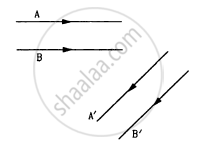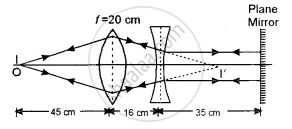Advertisements
Advertisements
Question
A light ray, going through a prism with the angle of prism 60°, is found to deviate by 30°. What limit on the refractive index can be put from these data?
Solution
Given,
The angle of the prism (A) = 60˚
The angle of deviation (δm) = 30˚
\[Refractive index, \]
\[ \mu \leq \frac{\sin\left( \frac{A + \delta_m}{2} \right)}{\sin\left( \frac{A}{2} \right)}\]
\[\mu \leq \frac{\sin\left( \frac{60^\circ + \delta_m}{2} \right)}{\sin\left( \frac{60^\circ}{2} \right)}\]
\[\mu \leq 2\sin\left( \frac{60^\circ\ + \delta_m}{2} \right)\]
As there is one ray that has been found which has deviated by 30˚, the angle of minimum deviation should be either equal to or less than 30˚ but it can not be more than 30˚.
Therefore,
\[\mu \leq 2\sin \left( \frac{60^\circ + \delta_m}{2} \right)\]
\[\mu \leq 2\sin \left( \frac{60^\circ \ + 30^\circ}{2} \right) = 2\sin \left( 45^\circ\ \right)\]
Refractive index (μ) will be more if angle of deviation (δm) is more.
\[\mu \leq 2 \times \frac{1}{\sqrt{2}}\]
\[\Rightarrow \mu \leq \sqrt{2}\]
Hence, the required limit of refractive index is \[\sqrt{2}\]
APPEARS IN
RELATED QUESTIONS
a) Give two reasons to explain why reflecting telescopes are preferred over refracting type.
Use the mirror equation to show that an object placed between f and 2f of a concave mirror produces a real image beyond 2f.
Use the mirror equation to deduce that the virtual image produced by a convex mirror is always diminished in size and is located between the focus and the pole.
Use the mirror equation to deduce that an object placed between the pole and focus of a concave mirror produces a virtual and enlarged image.
Define the term 'limit of resolution'?
Use the mirror equation to show a convex mirror always produces a virtual image independent of the location of the object ?
Can a plane mirror ever form a real image?
following Figure shows two rays A and B being reflected by a mirror and going as A' and B'. The mirror
Which of the following (referred to a spherical mirror) do (does) not depend on whether the rays are paraxial or not?
(a) Pole
(b) Focus
(c) Radius of curvature
(d) Principal axis
A light ray falling at an angle of 45° with the surface of a clean slab of ice of thickness 1.00 m is refracted into it at an angle of 30°. Calculate the time taken by the light rays to cross the slab. Speed of light in vacuum = 3 × 108 m s−1.
A small object is placed at the centre of the bottom of a cylindrical vessel of radius 3 cm and height 4 cm filled completely with water. Consider the ray leaving the vessel through a corner. Suppose this ray and the ray along the axis of the vessel are used to trace the image. Find the apparent depth of the image and the ratio of real depth to the apparent depth under the assumptions taken. Refractive index of water = 1.33.
Write any one use for each of the following mirrors :
(a) Convex
(b) Concave
The figure below shows the positions of a point object O, two lenses, a plane mirror and the final image I which coincides with the object. The focal length of the convex lens is 20 cm. Calculate the focal length of the concave lens.

For paraxial rays, show that the focal length of a spherical mirror is one-half of its radius of curvature.
A parallel beam of light is allowed to fall on a transparent spherical globe of diameter 30cm and refractive index 1.5. The distance from the centre of the globe at which the beam of light can converge is ______ mm.
When a clock is viewed in a mirror, the needles exhibit a time which appears to be 8:20. Then the actual time will be:
An upright object is placed at a distance of 40 cm in front of a convergent lens of a focal length of 20 cm. A convergent mirror of focal length 10 cm is placed at a distance of 60 cm on the other side of the lens. The position and size of the final image will be ______.
A convex lens of focal length 15 cm is placed coaxially in front of a convex mirror. The lens is 5 cm from the pole of the mirror. When an object is placed on the axis at a distance of 20 cm from the lens, it is found that the image coincides with the object. Calculate the radius of curvature of the mirror - (consider all-optical event):
